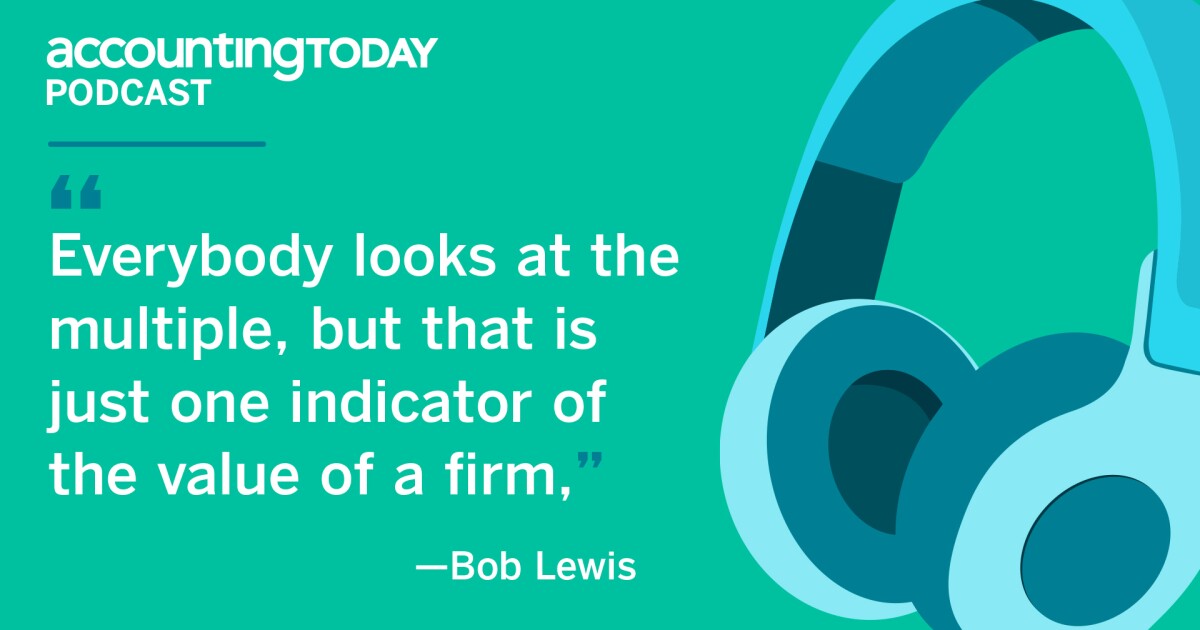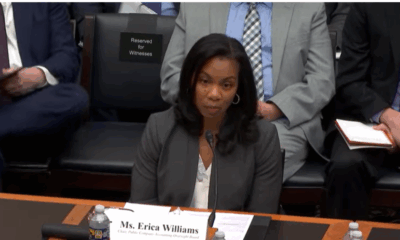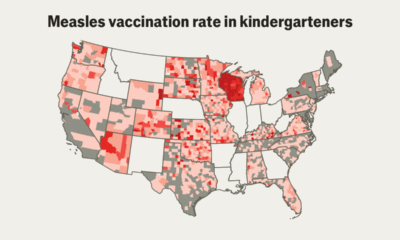Accounting
A primer on PE | Accounting Today
Published
7 months agoon


Private equity presents a lot of opportunities for accounting firms — but comes with a great many questions, too. Bob Lewis of the Visionary Group offers answers and valuable advice for accountants looking at this major trend.
Transcription:
Transcripts are generated using a combination of speech recognition software and human transcribers, and may contain errors. Please check the corresponding audio for the authoritative record.
Dan Hood (00:03):
Welcome to On the Air With Accounting Today I’m editor-in-chief Dan Hood. Private equity is on everyone’s minds these days as it reshapes the way accounting firms think about their structures, their business models, their growth strategies, and their succession and transition plans. Here to shed some light on the PE phenomenon, and what it means for accountants, is Bob Lewis of the Visionary Group who works with firms across the country on transitions of all kinds and has seen the inside of many of these PE deals. Bob, thanks for joining us.
Bob Lewis (00:26):
Dan, always a pleasure to talk to you.
Dan Hood (00:29):
I should also mention that Bob is the co-chair of our PE Summit Private Equity Summit, which is happening November 20 to 21st, Chicago. We’re going to be talking about all those issues at greater length, but today we’re going to get a little bit of a preview of all that sort of stuff. And I want to start by asking you, Bob, about what’s the attraction for private equity of accounting? What are they looking for when they come into the accounting landscape? What are they seeing? What draws them here?
Bob Lewis (00:54):
Well, the door kind got opened for them because of succession problems in the industry. So what they see though, is a large percentage of the revenue. Typically about 85% of the work is repeat work. It’s mandatory. I have to do return, I have to do an audit, I really need to have to get my accounting done. I could try and do some of this by myself, but pretty much it’s almost all being done by providers. They have large installed bases of clients that are often not cross sold to other services like wealth management insurance, cyber hr, take your pick. That’s a long, long list and the opportunity to take those firms and begin to increase the EBITDA off the firms is there. The other part that’s there now is there’s a large audience of even larger private equity firms looking at if we can pull all these people together, just think about the wealth management opportunity alone, average baby over 68, think about the transition of all the businesses inside, not just the firms but all their clients and all that wealth management and family office and trust estate and insurance opportunities. It’s endless. And I think that’s what’s drawing really into this market because large, large basic clients, if you think about it, accounting firms actually have probably every business in the United States.
Dan Hood (02:13):
That makes a ton of sense. Alright, so we understand. I understand now why private equity is interested in accounting, and I think we can understand this. I think it’s pretty straightforward why accountants are interested in private equity, right? They’re looking for sources of capital. They’re looking to manage transitions at a time when the next generation of talent really hasn’t materialized the way a lot of firms thought it should. They’re looking to support growth strategies that often involve m and a or major investments in technology or people. But if a firm is talking to a PE firm, an accounting firm is talking to a PE firm, what are the questions they should be asking when they sit down with a PE firm? What should they want to know from a PE firm as they think about a deal?
Bob Lewis (02:50):
Okay, the core question is how is the PE structure really going to help my practice? Is it going to alleviate some of the capacity problems I’ve got? How would that happen? What’s their back office look like? Do they have an offshoring model in place? How are they going to bring the things that I can’t do on my own to the table? And there is a massive resource imbalance in this country right now when we speak on these things, we talk about the size of the firms. How does a $10 million firm, who’s dropping $3 million to the bottom line compete with a hundred million dollar firm dropping $30 million to the bottom line, that million dollar investment is a million dollars on the 30 million profit versus a million dollars on a 3 million. It’s a huge investment to make. So what are the things they ask is what are the resources are going to bring to the table?
(03:36):
How are they going to be able to increase my capacity financially multiples and adjusted ebitda? And there’s a lot of variations that go in play here, but I would be asking the private equity firms, are they charging management fee? Do they have a preferred dividend? These are things that start getting hidden in a deal. What’s the amount of working capital required to move forward on a transaction? Everybody just looks at the multiple and the multiple is just one indicator of the value of a firm. The multiples applied to an adjusted ebitda. That’s the first thing you got to figure out. And the multiples are going to vary based on location, bench size, my interest in your firm. So there’s a little bit of art to that, but I would be really asking, what is a PE firm going to do for me? Is it going to buy out my debt issues? Is it going to give me the funds to acquire? And we’re seeing both, by the way. So we’re seeing firms take limited amount of private equity capital so they can have funding to want and make acquisitions or do other things by technology, whatever they want to do. The back office is key though, Dan.
Dan Hood (04:41):
Right. Well that makes a lot of sense. I think it’s interesting is that maybe a lot of accounting firms have just said, well, this is just another, just like a merger in a sense of we’ve seen what a traditional accounting firm into another accounting firm merger looks like and they think it might be looking like that. But there are obviously a huge number of differences between merging up into another firm though that brings plenty of changes of its own and sometimes pretty jarring ones for firms that maybe art experience with it. But PE firms, I think if I understand correctly, I mean that’s a whole other different set of changes that comes along with that when you partner with a PE firm in a way that a straight up merger doesn’t bring these complications. Maybe we can talk a little bit about if you’re looking to work with perform a deal with them, what kind of changes should you be expected to make or should you expect to make as an accounting firm? Well,
Bob Lewis (05:33):
More accountability because you now have a new investment partner. It doesn’t make a difference if you merge up into a top 100 firm where you take a private equity investment or a registered investment advisory investment, you’re going to have another group they need to report to. So there’s different sets of rules. Most of these PE firms are really not interested in running your practices. They have no desire to, they have no skillset do it, and they don’t want it. They’re looking at this as an investment, but they are looking for people to be able to make changes.
(06:05):
You can’t run your firm just is the, we’ve always wanted to run it. You now have to comply. I would also think one of the things too that most of these PE firms are looking at is more forced movement. So one of the things we see that stalls out in a lot of firms is I make a half million dollars a year as a partner or farmer, whatever my number is. Okay? And we’ve seen a hundred thousand to $4 million a year. The numbers were all across the board, but a product to make a firm, the problem that becomes though is I need to be prepared to go, look, I can’t be complacent and go, I make $500,000 a year and that’s all I need to do. I need to be looking at continuing to grow because it’s not just growth even for myself, it’s growth through the firm.
(06:47):
But if I’m making an investment in the firm, I’m a PE company, I need to see that EBITDA start to go up. You need to see reflections on it. And it’s not going to be by cutting jobs, by the, I want to make that really clear. These PE firms are not coming in and going, okay, now you got to cut 20 year people fact, if they tell you to cut 20 of year people, they’re probably killing themselves because their profitability will start to go down. They’re looking at, okay, we need to make a plan to hire 20 more people and we need to do that by getting more revenue or beginning to offshore, just using different tools that the firm just maybe couldn’t get to on their own. So Dan, I had one really strong awareness that hit me with private equity when it first came in the market, and it was always pretty non-private equity, everyone, you hear that basic news, you’re like, ah.
(07:32):
And it doesn’t work for everybody by the way, but it works for some people very well. One thing it made me crystal clear on is I am just not a good manager. I’m too soft on people. I’m too soft on, I’m too, I can get hung up. And I think that’s what happens in a lot of firms as you rise to a level and you’re the best person there to manage it. But I see firms that go from five to 20 million and they’re like, I’m dealing with stuff that I just never had to deal with before and then to go from 20 to hundred, it’s like I’m not set up to deal with all of these issues. And I think the structure helps a lot with when you merge upward and local private equity.
Dan Hood (08:12):
And you mentioned this, you mentioned accountability earlier on. Clearly this is a common problem for accounting firms is that management is hard and no one really likes it or wants to do with it. And then when you add to that, the fact that you’re talking about a partnership structure where everyone’s like, well, I’m a partner, we’re all partners, we’re all even, we’re all equal. We’re all equally partners. It’s hard to say to somebody who’s your equal, Hey, you got to do this. You missed your numbers last quarter. What’s up with that? You’re not doing enough mentoring, you’re not doing enough of this, you’re not doing enough of that. And I think that some firms may find that private equity is going to hold their nose to the grindstone a little bit more than their old group of partners might have.
Bob Lewis (08:50):
Well, and some of this is going to be, I hate to say this and it’s going to come across wrong, just audience, please bear with me on this. There’ll be some market correction. I maybe never should have been a partner to start with, okay, I don’t know how to mentor and I just want to grind out tax returns and I don’t want to leverage and teach people how to do stuff. I just wanted, I want to build $2,000 a year. I love billing $2,000 a year. It’s my favorite thing. Preferably, can I get $2,500 of billable time in a year and then work another a thousand that my dream has come true? But a lot of partners are in roles that they were promoted into because of the way the partnership was working at the time. And its models changed, and that’s one of the things we’re seeing now.
(09:32):
We see a changing with guard going on in a lot of firms where the more mature leadership has moved on, younger leadership comes in place and more changes start to happen. The problem is sometimes in the changing the guard situation, the younger leadership that now has taken over has to deal with some of the more legacy problems of I’m not a great partner, so how do we work around me? I can’t sell. I can’t bring in work. Don’t try and teach me to bring in work. I’m 63 years old, don’t tell how to work on the 40-year-old rig. That’s what we see a lot of.
Dan Hood (10:05):
Gotcha. Well, I want to talk more about those changes because one of the things, anytime we talk to anybody about anything, we always have to have the caveat that everything in accounting is a moving target. Everything in the field is changing in every aspect of the practice, but even in this little relatively recent microcosm of PE, it’s changing as we go on. So I want to talk dive a little bit more into that, but first we’re going to take a quick break. Alright, and we’re back with Bob Lewis of the Visionary Group. We’re talking about private equity and what it’s doing to accounting and just before the break, Bob was talking about change that’s going on in the profession and how things are changing at a fairly rapid clip. And one of the things I wanted to ask you about was do you see how private equity is approaching accounting firms changing? Is it different from what it was a year ago or two years ago? Are the types of deals that firms were interested changing? Are the terms changing as they look at different levels of accounting firms? What are you seeing in terms of change in there?
Bob Lewis (11:10):
So one thing is the market’s getting a little bit saturated. We’ve got for 10 million firms on, we’ve got ballpark 400 in this country that are probably viable for any kind of a private equity opportunity. And if you look at the 10 million to $5 million group, there’s according to the inside public accounting groups and things like that, there’s 500 firms, double it. Just say there’s a target of a thousand to 1500 possible viable ones. We are seeing private equity going lower now looking for more tuck-ins the one at more four or 5 million firms. The problem with those smaller firms, it becomes difficult to establish a proper adjusted EBITDA to be able to apply multiple to make the deal valuable to do so. I think we’re going to see more and more of that occur though as the core private equity firms get larger, they’re going to be able to do more and more I think, so that they’re going to go a little more downstream with some of the deals transactions.
(12:11):
I do believe a lot of the firms that are out there right now who said no to private equity, it doesn’t make any sense, are now starting to go, maybe I didn’t understand private equity. We see that all the time. We talk to managing partners, they’re like, I’ve talked to private equity and it’s not right for me. Their approach was completely wrong. I said, well, let’s revisit that. What did they tell you? What they told them was completely wrong. They got a call from a two person private equity company who just wanted to come in and talk about their numbers and they did nothing about the industry. They’re just trying to show them how the numbers work. We’re seeing a lot of that. Dan, I get three to four to five new private equity companies a week calling us to enter this market, and a lot of ’em, were dialing for dialogues, talking to major partners. Fact, when we initiate a phone call with the major partner note or we lead with, this is not a private equity call because they aren’t taking ’em so
Dan Hood (13:06):
Well. I was at a conference recently where a private equity firm that had been in this space for a while had done a couple of deals, was a veteran knew accounting very well, and they were talking about, they were saying, you have to understand that private equity, it’s sort of like a kid’s soccer game, like an eight year old’s soccer game, wherever the ball is, everyone runs to the ball. So they’re like private equity firms are going to start flooding into accounting or already have started flooding into accounting and many of them won’t know what they’re doing or where they’re kicking the ball or what game they’re even playing, but they’re going to all rush to the ball and try it out.
Bob Lewis (13:37):
It’s kind of funny. They all ask for a top 50 firm, I’ve got a 200 million fund. I’m interested in acquiring a top 50 firm. Well, yeah, good luck there. I’m sure Deloitte is thinking about selling for $200 million.
Dan Hood (13:53):
Yes. They’re just looking for the right PE firm to partner with.
Bob Lewis (13:57):
Yeah.
Dan Hood (13:59):
Well, but it’s interesting. It has, when it first started, people assumed it would all be just top 50 firms and they met all PE firms would buy some of those top 50 firms. They would become platform firms and go out and acquire others. But as you say, it’s getting smaller and smaller as we go forward. Do you think that that threshold will get lower? Is there a bottom below which you don’t really think private equity firms will be interested in?
Bob Lewis (14:22):
There is a bottom because you can’t make what the cool kids say, the scrape work. The scrape is the adjusted ebitda. I’m going to be able to pull out if I’m a private equity firm out the transaction to apply my multiple to. So that’s really the leftover profit. If assuming the partners are willing to work for this amount less or the gross profit, those numbers get too tiny. So if they get to a $3 million firm, and even if they’re dropping a million dollars to the bottom line on gross profit, by the time you adjust what they would still need to have to stay there, you may have a half million dollars worth of adjusted ebitda. I put a multiple of six on that and I’m back at $3 million. It’s not enough. Then the firms were all thinking, by the way, one of the things we’re seeing across the board, the 5 million firms getting a call from one of the smaller private equity firms going, oh, well, we will offer you 12 million for your firm.
(15:16):
Well then the deal falls apart because it never was able to make a deal work on 12 million to a 5 million firm, but then they want 12 million. So a number of legitimate call comes in from somebody looking to acquire for maybe pay them seven or eight and they want 12. Maybe I’ll take 10. I hear this all the time. Firms go, I won’t take anything less than 30 million from my firm. Well, the firm’s $15 million. How do you get to 30? Well, that’s what I want. It’s okay, I get it. They don’t feel like they necessarily need to sell. Most of these firms, some of ’em are getting cornered. They’re deferred comps, getting too large, too many retiring partners. They get a gap in leadership in the middle that impacts more smaller firms. The larger firms. Larger firms have a tendency to have better control over it.
(16:02):
But the larger firms are looking at this too, buying, I can get a lot of resources to acquire more firms and make a bigger net and have more leverage. The smaller firms are looking at this going, this could be an exit strategy for me to get out. I don’t have a succession team. And that’s where some of the missteps are occurring on how people are approaching this market. By the way, on your summit that you’ve got planned, not to make a pitch, but we are going to talking more about other options besides pe. We’re talking about how to remain independent ESOPs, just different things. I think that’s attracting some of the people we’re having coming to the summit. They wouldn’t care about just different options, what to do hunting equity.
Dan Hood (16:40):
Well, I mean the thing that’s exciting about private equity is not that it’s private equity per se or anything necessarily about it, but that it’s another option. It’s another thing that accounting firms can try as they look whether to deal with, as you said, their deferred comp issues, their transition issues, or to fuel their growth going forward. It’s another option. It’s in addition to merging up or just having an internal transition. Suddenly you have this third option, and then as you said, there’s an esop, why not look at that? And you could remain independent. But there are things you need to do, and I want to talk a little bit about what it would take to remain independent. But real quick, before we do that, I wanted to get your sense, if you have one, because early days, and no one really has any experience of this in the accounting space, there’s going to come a point at which private equity firms are going to reach their turn, right or whatever. That’s the phrase that you should talk about after their three to five to seven year holding period ends where they usually start looking to sell it. And I’m curious what happens when that happens As you look ahead to that, do you have any thoughts about what that’s going to look like in accounting?
Bob Lewis (17:40):
I think there’s going to be some bonds that fall apart.
(17:43):
I think there’s going to be some that move up to the second level. This is a little bit a brainstorming event from this one. They’re buying the first round and these are profitable. I’ve worked the math on these transactions too. Everybody makes money on these transactions the way it’s working right now. But the big money is banking on I’m going to increase your multiple a little bit, EBIT a little bit. We’re going to take all the firms, put ’em together, and all of a sudden I’m going to buy you at seven or eight and sell you at 14. Now, the reason why a larger firm, larger investment firm could be private equity, whoever, let’s listen better, call it an investment firm is interested in an aqua that newly created three or $400 million firm, massive consumer base, all of that work that these smaller firms can’t put in place on their own, all these services, they can’t put in place.
(18:36):
Larger entities can. In fact, I think a lot of the larger entities already own businesses that they could cross, all right, into the accounting firm space. I think this is going to be really interesting to see the first couple transactions that go to the next level. And I do believe there’ll probably be some more refinement and adjustments along the line. The question everybody has, is our deal values going to go up or down, like interest rates? Are they going to go up or down? And I think that’s going to be dependent on each private equity firm’s game plan and how they want to make investments. The other portal is too, is I do believe there’s going to be a secondary market emerging. So right now I want to buy firms in New York and Los Angeles and Houston and Dallas and Chicago, bigger areas. I think you’re going to see the next market coming.
(19:23):
I’m buying something in the middle of Kansas, the middle of Louisiana, middle of Alabama, whatever that no one wanted to necessarily go to initially. But there’s a firm there that probably needs the same love as a New York firm needed. And to me, those could be great buying opportunities that I do see that market beginning to, I think expand. But we’ll see where that goes. Right now, I think everyone must try to flush through the larger cities first to smaller tuck-ins into the cities that they currently have, and then go from there. And the really larger non-private equity firms, I don’t know how to describe this. If I’m one of the top 50 that want private equity and I took some private equity money, I’m using that money to acquire firms. I believe they’re already deploying that strategy, picking up firms in locations that aren’t necessarily mainstream hubs. And I think that’s
Dan Hood (20:15):
Well, and they’re pursuing, yeah, they’re pursuing whatever their growth strategy was before they’re boosting it now with all this, with the extra cash.
Bob Lewis (20:23):
Yeah, they really are.
Dan Hood (20:24):
But it probably always, as you say, it involved going out into those secondary, in some cases tertiary markets. But that was each firm’s individual strategy, whatever it might’ve been.
Bob Lewis (20:33):
So why would that smaller firm sell into a larger 10, call it a top 50 or top 100 firms that already took private money, equity money because that smaller firms got the same issues they can and make the investments in technology. They can’t make the offshoring work, they can’t get the advisor rolling and these other firm has it. Now, they may have to adjust some of the pricing based on the market they’re in, but think of it this way, we’re a global economy. Everything’s done through technology. I can be sitting in the middle of Arkansas in a slump. They have swamps in Arkansas, sorry, people in Arkansas. I think they had swamps at one point, I’m not sure. And working on a Manhattan business with no problem through the use of technology. So I can deploy people who are living in areas that they prefer to live in and use those people on higher end business clientele where I can’t get the people in the local markets I in to do the work, they’re already really moved away. I think that’s part of the whole equation here too.
Dan Hood (21:30):
Sure, sure. Absolutely. But you brought up, we have a couple of minutes left, and I wanted to dive into something you brought up, which is for many firms, they want to remain independent. They’re facing capacity constraints or capital constraints or transition issues. And so they may be looking, they may be exploring all these other options, but for many firms, their ideal position would be to remain independent. What does the firm need to do to remain independent in this era when it seems like everybody’s making a deal?
Bob Lewis (22:00):
Okay, so the biggest thing is it’s hard for me to remain independent if I can’t attract staff and I can’t retain staff, so I need to be prepared to make investments. And in technology, the artificial intelligence investments I think are going to be massive, but what they’re going to do is allow me to do more with the same amount of people I currently have. So if my revenue per professional head was $200,000 today, I think that’s going to be $400,000 moving forward because I’ve got this whole AI support bubble underneath me. I’ve got an offshoring arm supporting me. So the domestic labor shortage will begin to close the gap just from that technology benefit alone. And I think the question becomes, if I were to remain independent, can I afford to make those investments? Do I know how to manage those investments? Can I open up And advisory services are, that’s expensive.
(22:51):
And a lot of firms have struggled to figure out how to do that. They’ve even struggled to figure out how to partner with consulting firms to bring ’em into their clients and do a revenue share. And then I really need to be able to advance my client accounting services space because I think that’s a key to selling advisory and a key to also spreading revenue over a 12 month period and solving some of the labor issues. The problem is it’s a lot. I’m a $5 million firm and I’m already underwater clients and I can’t hire enough staff that’s five years away from me to be able to figure out how to get these things done assuming I could even manage it. And I think that’s what the decision is for remaining independent. The real asset tester, again, is simple. Do I even have a succession team in place?
(23:33):
If I do, can they sell in network? If they can’t sell in network and never really have, do I have enough time to train them to do that? Did they know how much it cost to buy into the firm? Did they know what the deferred cop payments are going to be to the X eight partners that they’re going to pick up a liability on? And the other part is, do they even want to be partners anymore? Because I’m going to tell you, I want to be a partner. If you ask me, Dan, do you want to be a partner at accounting today? Of course I do. What am I supposed to say? No, I don’t. I hate it today. I do not want to be a partner there. So I’m going to say, yeah, but when it comes time for me to sign the paperwork and do the buy-in, that’s a different
Dan Hood (24:11):
Compensation. I’ll jump to another firm and take a much larger salary.
Bob Lewis (24:14):
Well, maybe, but then three years have passed the time me ask you that question, be a partner, and then you want to make me a partner now and it’s three years closer to your retirement and I’d back out. That’s I think the biggest things you need to look at from remaining independent here. I will tell you, you got to raise fees. These firms are all under pricing, and they’re like, no, our clients won’t pay anymore. You got a capacity problem. What’s the difference if you lose your clients, if the other clients are going to pay more money to cover that? And they almost always do. But that’s what I would be doing if I had a firm right now, which I’m regretting not having a firm, to be honest with you, if I were 10 years back, I would be buying accounting firms left and right.
Dan Hood (24:53):
Well, no one really. I think it’s interesting you talking about that. No one 10 years ago, no one expected this flood, right? There was a big regular m and a standard accounting firm on accounting firm m and a market, but no one expected this explosion of pe. Or if they did, I didn’t hear ’em talking about it. And it’s an amazing opportunity, but it does require some thinking and some information as you approach it. To that end, I will make another grotesque plug for the PE summit. We think it’s going to be a super valuable event for accounting firms, but also for PE firms, for deal makers, for people who are facilitating these kinds of conversations. There’s going to be a lot of them on the ground. We’ve already got a lot of people signed up for it. We’re going to have a lot more by the time we get to November 20th and 21st in Chicago.
(25:39):
So I would recommend that if you’re interested in private equity in any way, I highly recommend you join us there. Bob’s going to be there along with, like I said, host of accounting firms, PE firms, deal makers, advisors and others. Register to share everything you ever want to know about private equity. But we’re afraid to ask. You can find more information on the summit and register to attend an accounting today.com. Like I said, Bob’s going to be there. So Bob, thanks for sharing everything with us today and we’ll look forward to seeing you in Chicago. Dan.
Bob Lewis (26:03):
It’s always a pleasure and it will be fun interest. It’s been interesting year. I think it’s going to be interesting next couple of years going forward here.
Dan Hood (26:10):
Definitely, definitely. Excellent. Alright. Thank you all for listening. This episode of On the Air was produced by Accounting Today with audio production by Win. We shamar ready to review us on your favorite podcast platform and see the rest of our content on accounting today.com. Thanks. You end to our guest and thank you for listening.
You may like
Accounting
BDO CEO Wayne Berson to retire, Matthew Becker tapped as successor
Published
10 hours agoon
May 29, 2025
BDO USA CEO Wayne Berson will retire effective June 30, 2026, and the firm’s national managing principal of tax Matthew Becker has been tapped by the board of directors to succeed him.
Under the Top 10 Firm’s CEO succession process, the board of directors selects a candidate and its principal group ratifies the candidate. Berson and Becker will meet with the firm’s principals over the next several weeks ahead of the ratification vote, which is expected to take place in July. Once a successor is agreed upon by a majority vote, the board of directors will announce the next CEO, whose term is expected to begin on July 1, 2026.

Berson has served as CEO since 2012. During his tenure, the firm has grown nearly 400% to annual revenues of roughly $3 billion, and he oversaw the firm’s transition from a partnership to a corporation and then an
As national managing principal of tax, Becker oversees the strategy and operations of BDO’s tax practice, which includes over 3,500 tax professionals. He is a member of BDO’s executive leadership team and a member of BDO International’s global tax advisory committee. Becker has also served as chairperson of BDO USA’s board of directors.
The firm plans to provide no further updates until the conclusion of the voting process to ensure a “thorough and unbiased evaluation period for BDO”s principal group,” according to the release.

Pardon us; no relief in sight; down on the farm; and other highlights of recent tax cases.
San Francisco: Winery co-owner Brian Fleury, 64, of Napa County, California, has pleaded guilty to aiding and assisting the preparation of a false return.
Fleury and his spouse owned the winery Metropolitan Wines and several vineyards in Napa Valley. For tax years 2014 through 2018, Fleury underreported Metropolitan’s income to his tax preparer. Fleury directed some customers to pay with checks directly to Fleury instead of to Metropolitan and wrote or told his employees to “off the books,” on some of these customers’ invoices. Fleury kept these payments for himself and did not report this as income.
Between 2014 and 2018, he underreported his and his spouse’s income by $822,450.
Fleury also admitted that from 2007 through 2019, he failed to pay federal excise tax that was due on brandy he received, possessed and sold, filing annual reports with the U.S. Department of the Treasury, Alcohol and Tobacco Tax and Trade Bureau that he knew were false.
In total, he caused a tax loss to the IRS and TTB of $211,092.
Washington, D.C.: President Trump has pardoned Paul Walczak of Palm Beach Gardens, Florida, two weeks after Walczak’s
Walczak, who was convicted of evading more than $10.9 million in payroll taxes and sentenced to 18 months in prison and two years of supervised release, controlled a network of interconnected health care companies operating under various names, employing more than 600 people.
In 2011, Walczak did not pay two quarters of withheld taxes to the IRS. He evaded collection efforts and continued not paying over taxes from employees’ paychecks and keeping the money to fund what authorities called a lavish lifestyle, including the purchase of a yacht.
He caused a total federal tax loss of $10,912,334.80 and was also ordered to pay $4,381,265.76 in restitution.
Walczak is the son of Betsy Fago, a longtime Republican donor who recently attended a Trump fundraising dinner,
Trump was slated to pardon reality show stars
Athens, Georgia: Tax preparer Jessica Crawford, 34, who previously
FBI agents investigating a multistate unemployment benefit scheme that was conducted during the pandemic discovered texts between conspirators and Crawford, a preparer with Crawford Tax Services. Crawford filed for PUA benefits on behalf of those individuals who had created fake businesses or submitted false information to steal benefits. In return, she received a percentage of the gains.
In 2022, an undercover IRS agent met Crawford to have their taxes prepared, and Crawford asked if the agent did anything on the side. At first the agent said no; Crawford replied that expenses could be deducted. The agent said he sometimes mowed an aunt’s lawn but provided no income or expense amounts. Crawford created a Schedule C business for landscaping on the agent’s federal return and prepared a 1040 and a fictitious Schedule C loss of $19,373, as well as claimed an Earned Income Tax Credit, a Child Tax Credit and a qualified business income deduction. As a result, the agent’s return claimed a fraudulent federal income tax refund of $12,359.
The IRS reviewed 1,261 returns filed by Crawford in tax years 2020 and 2021 and determined that she fraudulently filed returns on behalf of clients, resulting in losses to the IRS exceeding $3 million from false 7202 credits for sick leave and family leave, tax credits and dependent care credits.

Marina Del Rey, California: Elana Cohen-Roth, 81, a retired IRS agent, has been sentenced to 12 years in prison after being convicted of 23 felony offenses related to defrauding an elderly victim of her life savings.
Cohen-Roth exploited a professional and personal relationship she’d had with an elderly area resident. A retired IRS agent and professional tax preparer, Cohen-Roth began preparing the then 66-year-old victim’s taxes in 2013. From their friendship, Cohen-Roth gained access to all the victim’s financial information. Cohen-Roth told the victim she would invest in some type of real estate to earn at least 10% at “no risk.”
From December 2013 through September 2019, Cohen-Roth extended “investment opportunities” to the victim on more than 20 occasions in amounts from $25,000 to $150,000. Each time, the victim took money from her legitimate investments and wired it to Cohen-Roth.
Bank records revealed that Cohen-Roth was running a Ponzi scheme where other investors also deposited large sums into her account. Cohen-Roth used some of the elderly victim’s money to pay off these earlier investors and used the rest to support her lavish lifestyle and make gifts to family members.
By September of 2019, the victim had depleted her investment accounts and took out a reverse mortgage to send additional money to Cohen-Roth. The scheme collapsed in 2020 when the victim demanded a return of some of her money so that she could move near her family. Cohen-Roth did not have another source to repay the victim, who did not receive any of her money back.
A jury convicted Cohen-Roth of all 23 felony financial fraud charges. Because of her age, she was sentenced to the middle term of 12 years in state prison rather than the maximum of 28 years.
Richmond, Virginia: Tax preparer Baltej Singh Brar, 42, of South Richmond Hill, New York, has been sentenced to two years in prison for making false statements on loan applications he submitted for clients through pandemic relief.
Brar owned and operated Aspire Tax & Accounting Services and in 2021 began filing loan applications on behalf of other individuals through the Paycheck Protection Program. He advertised that he would file loan applications in exchange for an upfront fee and 10% of the loan value after approval.
Brar instructed prospective applicants to provide him with their Social Security numbers, a copy of their driver’s license, email address, prior bank statements, their 2019 return and a voided check to be used as supporting documentation. Most of Brar’s clients were sole proprietors, including taxi drivers, truck drivers and construction workers. Where clients’ prior year incomes fell below the threshold to receive the maximum PPP loan of $20,833, Brar inflated the income amounts in the applications. Brar caused the Small Business Administration at least $550,000 in losses.
Greensburg, Pennsylvania: Accountant Jonathan A. Weston, a resident of Canonsburg, Pennsylvania, has been sentenced to 27 months in prison and ordered to pay more than $8 million in restitution after being convicted of fraud conspiracy, conspiracy to commit money laundering and filing false income tax returns.
From October 2005 to January 2019, Weston, an accountant for Hillandale Farms Co., schemed with another employee to embezzle some $6.8 million from the company and launder the money through businesses they both controlled to buy collectible cars, real estate and other items.
Between 2013 and 2018, Weston also either failed to file or filed false federal personal income tax returns, including filing a false return in which he underreported more than $500,000 stolen from Hillandale.
He was ordered to pay $6,870,128 in restitution to Hillandale Farms and $1,216,176 to the IRS. He was also ordered to forfeit assets from his crime, including a 2008 Aston Martin, a 1933 Ford Model 40 Coupe and a condominium.
Accounting
Counties with highest capital gains per 2025 study
Published
11 hours agoon
May 29, 2025

The more value that investors can receive in the form of long-term capital gains rather than ordinary income, the less they will pay back to Uncle Sam.
Those in the 20 counties below ranked by the average net capital gains reported on their federal returns to the IRS are getting above-average appreciation on their assets with much lower tax rates, generally, than their incoming income,
For financial advisors and their clients, the list provided
“Net capital gains represent the profits a taxpayer recognizes from selling a capital asset after offsetting capital losses. These gains are often created by highly appreciated assets,” Kathy Buchs, a senior tax advisor, team leader and managing director with Cleveland, Ohio-based registered investment advisory firm
“We take geography into account when advising clients to sell an asset or consider tax loss harvesting due to
That difference in tax rules at the state level raises the possibility of strategies such as an incomplete gift non-grantor trust that, in some areas, could “eliminate the state taxation of the trust-owned portfolio,” said Richard Austin, an executive director for estate and business planning with San Diego and Waltham, Massachusetts-based RIA firm
“Tax efficiency significantly impacts the performance of a client’s portfolio by maximizing the after-tax return on investments,” Austin said. “Investing across different countries and regions can reduce portfolio volatility. Markets in different parts of the world often have low correlation, meaning they don’t always move in the same direction at the same time. If one market experiences a downturn, others might perform well, potentially stabilizing overall returns and the potential for future capital gains. State-specific tax rates impact tax efficiency of a portfolio. The difference in state income taxes creates a significant layer of complexity in achieving tax efficiency for a client’s portfolio.”
Even though any type of data presents the possibility of noise factors affecting any particular region, the study “highlights that taking geography into account is essential when advising clients on their asset allocations,” said Michelle Ash, a senior wealth advisor with the Jacksonville, Florida-based office of RIA firm
“Net capital gains is measured when a person is selling assets, and so it requires past investment success to be in that position,” Ash said in an email. “It’s no surprise to me that Florida would be the top state by this metric. Florida has no state income, inheritance or estate taxes, and so it’s a beneficial place to live when you’re selling assets. These Florida traits also attract a lot of retiring individuals who may be selling assets like homes and businesses when they retire or move.”
In focusing on capital gains, SmartAsset sought to home in on the areas where investors netted the most gains with preferential rates compared to ordinary income, according to the report’s author, SmartAsset Director of Economic Analysis Jaclyn DeJohn.
“Net capital gains, the profits from selling assets like stocks, real estate or businesses, are a key measure of investment success
Besides the listing below, here are some of the other interesting takeaways from the study:
- Three Georgia counties, Chattahoochee, Quitman and Taliaferro, displayed the smallest average net capital gains, at $2,400 or less. Fewer than 10% of returns in the counties had net capital gains.
- At the state level, West Virginia tax returns had the lowest average net capital gains at $14,612, followed by Wisconsin with $19,590 and Iowa with $20,220.
- On the other end of the spectrum among the states, federal returns out of Florida ($84,911), Wyoming ($84,246), Nevada ($77,491), the District of Columbia ($58,733) and Texas ($52,926) reported the highest average net capital gains.
Scroll down the slideshow for the ranking of the top 20 counties in the U.S. in terms of average net capital gains. To see a list of the top 10 cities with the highest income among retirees,
Note: The below rankings are based on a report by SmartAsset called, “

U.S.-China talks ‘stalled’ and need Trump and Xi to weigh in, Bessent says

BDO CEO Wayne Berson to retire, Matthew Becker tapped as successor

Tax Fraud Blotter: Side hustles

New 2023 K-1 instructions stir the CAMT pot for partnerships and corporations

The Essential Practice of Bank and Credit Card Statement Reconciliation

Are American progressives making themselves sad?
Trending
-

 Accounting1 week ago
Accounting1 week agoHouse tax bill includes provision eliminating PCAOB
-

 Economics1 week ago
Economics1 week agoWhat happens if the Inflation Reduction Act goes away?
-

 Personal Finance1 week ago
Personal Finance1 week agoWhat House Republican ‘big beautiful’ budget bill means for your money
-

 Accounting1 week ago
Accounting1 week agoTrump tax bill faces Senate’s arcane rules, desire for changes
-

 Finance7 days ago
Finance7 days agoPersonal finance app Monarch raises $75 million
-

 Economics1 week ago
Economics1 week agoA court resurrects the United States Institute of Peace
-

 Economics1 week ago
Economics1 week agoHow much worse could America’s measles outbreak get?
-

 Economics1 week ago
Economics1 week agoCalifornia has got really good at building giant batteries
